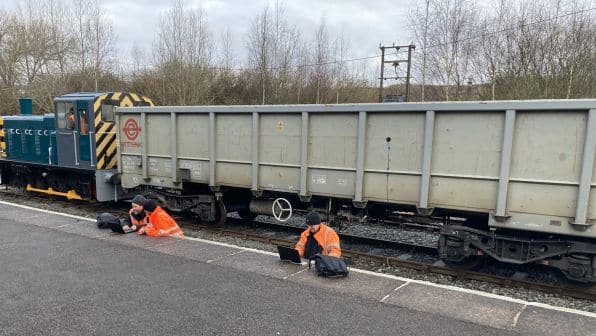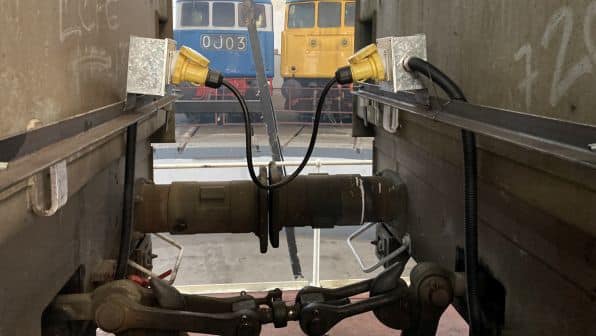WITH proof of concept testing now successfully completed using six wagons and a shunting locomotive, Railfreight Consulting’s managing director, Mr Ralph Goldney, reports significant interest from the British rail freight sector in the company’s Intelligent Wagon (IW) system that provides real-time monitoring of wagon performance and component systems, alerting the driver or control centre if a fault develops that poses a risk to safe operation. Discussions over potential mainline trials are underway with freight operators, British infrastructure manager Network Rail (NR) and wagon leasing companies, as well as major freight customers in the aggregates, container shipping, power generation and fuel sectors.
Goldney says that companies moving large consignments by rail are keen to mitigate the risk to business continuity posed by wagon faults causing a derailment or other accident that could interrupt rail access over several days as the incident is investigated and any damage repaired. This was most recently highlighted on December 24 2021, when five wagons of a 33-wagon intermodal train derailed at low speed when entering the rail terminal at the London Gateway container port in Essex. While there were no injuries, the damage caused to rail infrastructure by the derailment disrupted rail access to the port for 14 days.
The IW project has its roots in work undertaken by Railfreight Consulting for the Rail Safety and Standards Board (RSSB) to examine the business case for fitting the 12,500-strong British wagon fleet with the Digital Automatic Coupler (DAC).
Now being developed with funding from the European Union (EU), DAC combines an automatic coupler with air, power and data connections, enabling the transmission of data gathered by wagon-mounted sensors. Industry workshops conducted as part of Railfreight Consulting’s work to evaluate the business case came to the firm conclusion that the British rail freight industry did not require a costly new coupler such as DAC, the high price of which is already a matter of concern to some of the smaller freight operators on the European mainland.
The official cost estimate for rolling out DAC across Europe is €10.6bn, but €15-20bn according to Poland’s Federation of Independent Rail Operators (ZNPK) which says that this poses “a real threat to the entire industry.” As Goldney points out, the absence of wagonload traffic in Britain means that there would be little to gain from the automatic coupling and uncoupling of wagons, whereas larger freight operators in continental Europe, who continue to shift large volumes of wagonload freight, are expecting major efficiency, cost and safety benefits from removing the need for ground staff at major marshalling yards.
However, considering the business case for DAC in Britain did reveal that there would be significant advantages from adopting a system able to monitor faults and issue status reports in real time.
“We’ve given a freight train about 10% of the brains of a passenger train.”
Ralph Goldney, managing director at Railfreight Consulting
This was underlined by the serious freight train derailment that took place near Llangennech in South Wales on August 26 2020, described by Goldney as “shocking,” and which led to NR providing funding for the IW proof of concept trials.
The failure to detect a locked wheelset on one of the train’s 25 tank wagons, probably caused by a defect in the braking system, resulted in a derailment that spilled 446,000 litres of diesel fuel, causing a major fire and serious environmental damage with 330,000 litres of unburnt fuel spilling onto surrounding marshland.
As the Rail Accident Investigation Branch (RAIB) notes in its report, “had this accident occurred close to centres of population, involved more volatile fuel, or if more of the train’s contents had been involved in the fire, the direct human consequences could have been considerably worse.” The accident was of particular concern to other parties involved in moving hazardous materials by rail, Goldney notes, such as the consignments of aviation fuel for Heathrow Airport moving through central London.
RAIB recommended that NR, RSSB and the National Freight Safety Group should identify ways of improving the ability to alert a driver, signaller or control room to a wagon defect that might cause a derailment, such as dragging brakes or an axle bearing failure, by reviewing technology and systems in use in Britain and other European countries. Specific consideration was to be given to wagon equipment capable of detecting a safety-critical fault and transmitting an alarm.
The train involved in the Llangennech accident travelled for 100km before the derailment took place, passing six signalboxes where the signallers did not report anything untoward which would have required them under the general signalling regulations to stop the train for examination. The train also passed over a hot axlebox detector (HADB) 14km before the site of the derailment, and subsequent examination of data recorded here indicated that the front wheelset on one wagon was not rotating. A wagon-mounted fault detection system such as IW has the potential to alert the driver immediately to such a fault and is not dependent on lineside equipment which, as Goldney points out, cannot be installed everywhere, principally for reasons of cost.
Keeping it simple
“We think IW is a major step forward in the safety and efficiency of rail freight,” Goldney says. In designing the new system, Railfreight Consulting has followed the principle of “keep it simple, stupid” or Kiss, producing a flexible and scalable system that can be tailored to user requirements and installed quickly and easily. “We’ve given a freight train about 10% of the brains of a passenger train,” he says. “We can do this very quickly, there’s nothing new here.”
The core IW infrastructure is based on a power line running down the train, which also carries communications signals to and from the locomotive cab. Goldney points out that powering sensors and other wagon equipment from the locomotive is cheaper, more reliable and requires less maintenance. It is also more suitable for use on wagons carrying inflammable or other hazardous materials than axle-end generators or solar power, removing the need for any power to be generated or stored on the wagon itself. Using a physical connection is also more reliable and more suited to hazardous materials applications than Wi-Fi, Goldney believes.
The four constituent elements of the core IW infrastructure include the locomotive node, which provides a 48V dc supply from a standard 5kWh battery, charged by the locomotive’s auxiliary power supply. The locomotive node also provides the data hub for communication with the driver or the internet.

The locomotive and the wagons are connected by jumper cables with three-pin plugs. “It’s simple and more reliable,” Goldney says. “It works.” On each wagon there is a conduit for the power cable running from one end to the other via the wagon node, which brings current down to 24V dc to power onboard equipment, with 30W of power available on each wagon. The wagon node also provides the data connection between the power line and monitoring equipment, and is connected to a wagon-mounted coding plug to enable precise identification of the wagon. Goldney says that the wagon node can handle an analogue yes/no feed - such as whether a wagon handbrake is on or not - as well as a digital feed of data running on a scale, such as the payload of the wagon.
Yet to be developed is the admittedly rather crucial means of connecting the locomotive node to the driver advisory system.
Goldney points out that different advisory systems are now being used by freight operators in Britain, and as well as being operator-specific this interface would also be bespoke for each sub-class of freight locomotive.
At the simplest level, Goldney says that in future the driver could be alerted by two different visual and audible warnings in the cab, one to indicate “stop when you can” in the event of a developing fault and the other instructing the driver to “stop immediately” in the event of a derailment, locked axle or other major fault. Goldney stresses that IW warns the driver rather than applying the brakes automatically, as this would require modifications to safety-critical systems that would add to the cost and complexity of wagon fitment, particularly with regard to assurance and acceptance. “We just need to tell the driver to put the brakes on,” he says.
Wide range of applications
The core IW infrastructure provides immediate fault reporting on train separation. If a train becomes divided and the driver is not aware, the brakes will be applied on the wagons that remain attached to the locomotive, causing wheel flats as the head section of the train continues on its journey. The new system also enables the train consist to be checked automatically, removing the need for ground staff to manually collect wagon data and feed it into the Total Operations Processing System (Tops), which has been used to manage rolling stock movements in Britain since the 1970s. This alone could save 30 minutes on train preparation. Looking further ahead, IW would also be an enabler for providing train integrity functionality under ETCS Level 3, monitoring train length and whether it remains complete from head to tail.
Following industry consultation, Railfreight Consulting selected three monitoring applications to demonstrate: derailment, loading status and handbrake status notification. Based on four sensors installed on each bogie measuring weight in 5 tonne increments, the loading status application can determine if the wagon is full or empty or has been loaded unevenly. As well as the safety benefits from avoiding overloading, this could improve productivity as wagons can be accurately loaded to their maximum payload. As Goldney points out, this would be particularly useful when loading wagons during engineering possessions or handling construction spoil, the weight of which can vary considerably according to its moisture content.
IW would also be an enabler for providing train integrity functionality under ETCS Level 3.
Other potential applications include wheel slip/slide management, remote condition monitoring, brake pressure measurement and wagon mileage measurement. IW could support applications for measuring brake and wheel wear, and enable wagon maintenance to move from a typical overhaul every seven years to true condition-based maintenance. GPS location, ensuring that containers are correctly loaded, and checking that hopper doors are closed are also possibilities. Infrastructure monitoring and automatic brake testing could be accommodated, as well as rear-facing cameras or radar that would enable drivers to reverse trains without the need for ground staff to direct them.
The cost of installing IW will vary according to the level of monitoring required and fleet size, each wagon type having an individual design and assurance cost. Once the necessary equipment has been procured, Goldney says that around four months would be required to complete systems integration work and obtain assurance approval “so that the entity in charge of maintenance (ECM) is happy.” Wagon fitment could then be undertaken “in a couple of days,” he says.
Railfreight Consulting believes it can offer a typical solution for around £50 per wagon per month, based on a 10-year contract. As a typical wagon leasing charge is £1000 per month and represents around 15% of the total cost of rail freight to the customer, this would add less than 1% to the total cost. Given the potential benefits that could accrue from this comparatively modest outlay, Goldney is predicting rapid uptake of IW. “I will be amazed if that does not happen this year,” he says.

